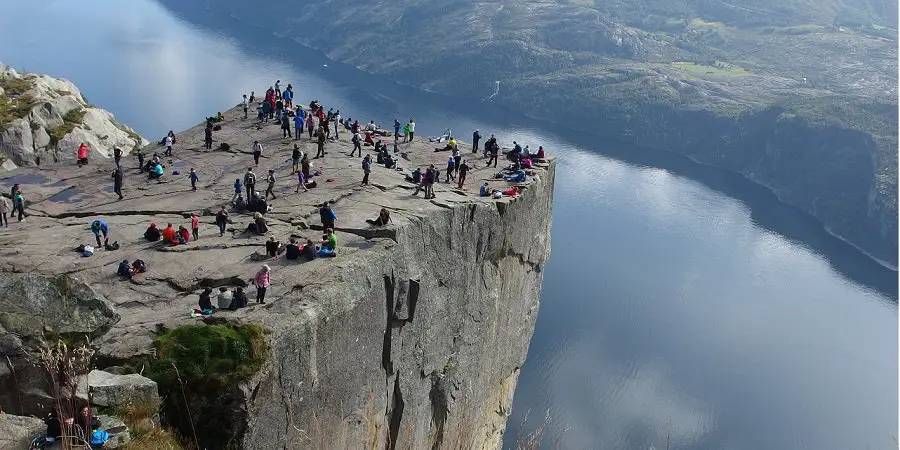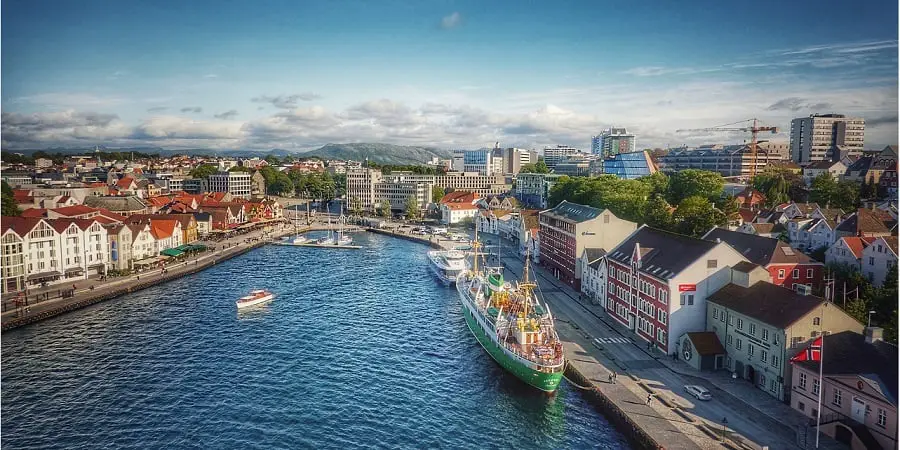Norway is famous for its stunning nature scene. It is also known for many picture-worthy nature formations. One of the most famous is pulpit rock (preikestolen).
The square-shaped, steep cliff that resembles a pulpit (hence its name) rises more than 600 meters from the fjord below, providing a stunning view that has made it one of Norway’s top tourist attractions. Only reachable on foot, you have to endure a 4-hour hike to get there. The trail can be quite steep at times making it medium-difficult. To have the best experience, you need to have enough warm clothes and a pair of good hiking shoes.
Continue reading below to learn everything you need to know to prepare yourself for the hike to one of the world’s most famous rock formations.

About
Pulpit rock is a rock cliff located in Rogaland county in southwestern Norway. It gets its name from its square shade which makes it resemble a pulpit. The cliff rises just over 600 meters from the Lysefjord located below. The top is completely flat which makes it a great viewpoint.
The combination of the unique rock formation and the majestic view from the top has made it one of Norway’s most popular tourist attractions. In 2019 more than 300 000 visitors made the hike.
Getting there
The pulpit rock can only be reached by foot. The trail starts out at the base camp, which is located about 3.8 km west. The base camp can be reached by car and bus from Stavanger, which is the closest larger city.
Car
Base camp is an 8-hour ride from Oslo and a 5-hour drive from Bergen. Therefore, you are better off staying in Stavanger when making the trip. The drive from Stavanger is about 40 km west and takes about 50 minutes.
The drive takes you across the fjord from Stavanger through a sub-sea tunnel that opened in late 2019. To use it you have to pay a toll fee of 140 NOK (about 16 USD and 14 EUR). Once you exit the tunnel you follow route 523 south and follow the signs to base camp.
Once you arrive there is a parking area for up to 1000 cars. Currently, a day ticket costs 250 NOK (about 30 USD or 25 EUR).
Bus
from March until the end of November there are daily bus trips between preikestolen and Stavanger. The bus runs from several hotels and hubs in Stavanger. A standard roundtrip ticket for an adult costs 325 NOK (About 38 USD or 32 EUR).
Tickets are limited in the high season, so make sure to book online in advance. By doing so, you also get a discount. Check out their website for the timetable and more information.
Ferry
For a complete experience, you can go for a combined fjord cruise and hike to pulpit rock. The cruise sails from Stavanger through unforgettable fjord landscapes, passing idyllic islands, rocky shores, and steep mountains with powerful waterfalls.
You also get to see the pulpit rock from below before being dropped off at the village of Forsand. From here you take a bus to the base camp from which you make the hike to the plateau.
Read more on the company’s website here.
What to bring

The hike to pulpit rock is almost 4 km one way, for a total of 8 km roundtrip. While the hike is considered relatively easy by Norwegian standards. It can be challenging for someone who is not an experienced hiker. To have the best experience, you need to bring the correct equipment.
The weather is always a factor in Norway. Even though you set out while it’s sunny, there might be windy and rainy when you return. Therefore, it is very important to have proper and warm clothing that is suitable for the season. Also, make sure to bring a decent-sized backpack for an extra raincoat, sweater, and thermal underwear.
The trail follows the mountains up to a total elevation of 350 meters. The trail is rocky and can be wet, so make sure you bring a good pair of hiking shoes. While you can get away with regular jogging shoes in summer. They offer little or no ankle support which can come in handy on the rocky trail.
Make sure to bring enough food and drink for the trip. For most hikers, the trip takes between 4-6 hours. It is also wise to bring a little extra should there be any unexpected delays. Other useful items include a first aid kit, a headlight should you be delayed, and loose daylight (especially during spring and autumn). Finally, make sure your phone is fully charged before you set out.
These are the most important items. Before you head out, make sure you tailor your equipment to meet your needs. For even more tips, check out the video featuring Norwegian Nature guide Johannes Apon below.
The trail
With an elevation of more than 300 meters, the trail is not always as easy as many make it out to be. In fact, a relatively steep climb awaits you soon after leaving base camp. That being said, the trail is well-groomed and features sections with boardwalks and gravel pathways However, many portions are natural terrain, which can be wet, slippery, and muddy.
About halfway, the trail flattens out, and soon spectacular views start appearing. Do not worry, you will still be able to keep track of the trail which is clearly marked with red paint. To see the trail yourself, you can check out the video below from a hike by a visitor in 2017.
The plateau is about 25 by 25 meters which is plenty of space for all the highly hikers. Surprisingly to some, there are no railings along the edges. This is a deliberate decision as if not to disturb the natural beauty of the rock. Do not worry, the plateau offers enough space, and as long as you stay clear of the edge you should be out of harm’s way.
Despite being largely downhill, many hikers experience the descent just as challenging as the way up, so make sure you have enough in the tank for the return trip.
Where to stay

Driving from Oslo and bergen takes about 8 and 5 hours respectively. Therefore, you are better off making your trip to pulpit rock a weekend or a 2-day trip. The closest bigger city is Stavanger from which you can hop on the fjord cruises up the fjord below, or get on the bus to base camp for the hike.
Stavanger is Norway’s oil capital and there are plenty of hotels throughout the city. Check out the listings on booking sites such as hotels.com and book early to get a good deal. While prices vary, you can get a 3-star hotel room for 2 adults for about 1000 NOK per night (about 115 USD or 100 EUR). You can also check out Airbnb listings.
You can also book accommodation at the base camp. From April 1st Preikestolen basecamp offers several accommodation options at or near base camp. You can choose between, affordable, small hiking nests in the hikers’ camp, private rooms, and a private lakefront water camp. Check out their website for more information.
Safety Tips
Every year, Rescue operations are triggered by hikers to the pulpit rock. Most of these rescue operations come as a result of being ill-equipped and prepared for the trip. Don’t be one of them, prepare yourself properly for the hike, and join a guided hike if you’re not an experienced hiker.
The most important thing to maintain the safety of yourself and your traveling companions is to make sure everyone is properly dressed and has proper shoes. Also, make sure to bring a fully charged cell phone. If something happens you want to be able to call for help. Bring along a first aid kit. And last, but not least, as a foreigner, you want to make sure you have travel insurance that will cover any cost should you need medical assistance or rescue from the mountain.
With regards to the actual hike, the trail is considered very safe and experiences very few accidents. Once you are on top of the plateau make sure to consider the wind before getting too close to the edge. Gusts can be much stronger than lower down the mountain.
Hiking to pulpit rock in winter
Pulpit rock is mainly a destination from spring to autumn. While you can make the hike during winter, it is not recommended without the necessary gear and experience. When making the trip in winter, Hikers should be prepared with clothes and shoes for cold weather.
Depending on weather, snow, and ice conditions, the trail may become slippery in some of the more demanding areas. Here you might need crampons to make your way up. Last but not least, daylight is limited in Norway during the winter months to add to the challenge.
If you have some experience and would like to experience pulpit rock as a winter wonderland, Lysefjorden adventure offers guided winter hikes to pulpit rock. Check out their website to learn more.
FAQ’s
How long does it take to hike to the pulpit rock?
The hike is about 3.8 km each way. The average hiker uses between 1 and 2 hours on the way up and a slightly shorter time on the way back. Depending on the traffic, and how long to stay to enjoy the view, the trip takes about 4 hours.
How difficult is the pulpit rock hike?
For most Norwegians, the hike is fairly easy. For the average tourist, it should be considered to be of moderate difficulty. Proper shoes and clothing will make the hike easier, especially given how changing weather conditions can make the hike tougher.
Has anyone died at pulpit rock?
Yes, a few unlucky individuals have fallen to their deaths from pulpit rock. Others have jumped willingly in suicide pacts.
How high is pulpit rock?
Pulpit rock rises 604 meters above sea level in the Lysefjorden below.
Where do you park for pulpit rock?
There are about 1000 parking spots at the pulpit rock base camp from which the trail starts. A day ticket costs 250 NOK (about 30 USD or 25 EUR).
How do you get to pulpit rock from Stavanger?
You can get to the pulpit rock base camp by car and bus. The drive from Stavanger is about 40 km west and takes about 50 minutes. It will take you across the fjord from Stavanger through a sub-sea tunnel that opened in late 2019. To use it you have to pay a toll fee of 140 NOK (about 16 USD and 14 EUR). Once you exit the tunnel you follow route 523 south and follow the signs to base camp.
How do you get to pulpit rock from Bergen?
The easiest way to get from Bergen to pulpit rock is by car. The fastest route is along highway E39. Drive south to Stavanger, after which you head west to reach pulpit rock. The derive will feature several ferries and troll highways and takes over 5 hours.

